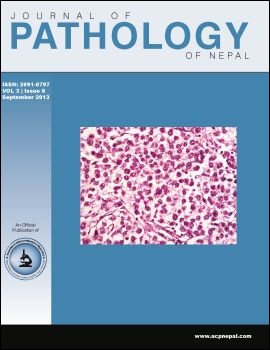Clinico-histopathological correlation of skin biopsies in leprosy
DOI:
https://doi.org/10.3126/jpn.v3i6.8992Keywords:
Granulomatous skin lesion, Leprosy, Skin biopsyAbstract
Background: In leprosy, there is a range of varied clinicopathologic manifestations and the diagnosis is made from adequate clinical information combined with bacilloscopy and histopathology which helps in diagnosing different types of leprosy and separating it from other granulomatous lesions. Aim of the study was to classify leprosy according to Ridley Jopling classification and perform the clinicopathological correlation.
Materials and Methods: A cross sectional comparative study of skin biopsies of newly diagnosed leprosy recieved over a period of 18 months from January 2009 to June 2010 and clinicopathologic correlation was done along with special stain.
Results: This study included 75 patients diagnosed clinically as leprosy. Skin biopsy revealed evidence of leprosy in 72 cases. Maximum number of patient clinically belonged to tuberculoid leprosy which constituted 25 (33%) cases followed by borderline tuberculoid 19 (25.33%). On the contrary, histologically borderline tuberculoid was the most common type (40%, n=30) cases and tuberculoid leprosy constituted (13.33%, n=10) cases. Three cases of clinically diagnosed tuberculoid leprosy showed no features of leprosy histologically. Clinical and histopathological correlation was seen in 34 cases (45.33%). The correlation was highest in borderline tuberculoid (63.15%) followed by borderline lepromatous and lepromatous leprosy. Slit skin smear was positive in 31 cases (43.05%). Fite Farraco stain was positive in 18 cases (25%).
Conclusion: The classification of leprosy requires attention to the histopathological criteria and correlation with clinicalinformationand bacteriological examination so as to facilitate accurate therapy to prevent undesirable complication.
DOI: http://dx.doi.org/10.3126/jpn.v3i6.8992
Journal of Pathology of Nepal (2013) Vol. 3, 452-458
Downloads
Downloads
Published
How to Cite
Issue
Section
License
This license enables reusers to distribute, remix, adapt, and build upon the material in any medium or format, so long as attribution is given to the creator. The license allows for commercial use.




